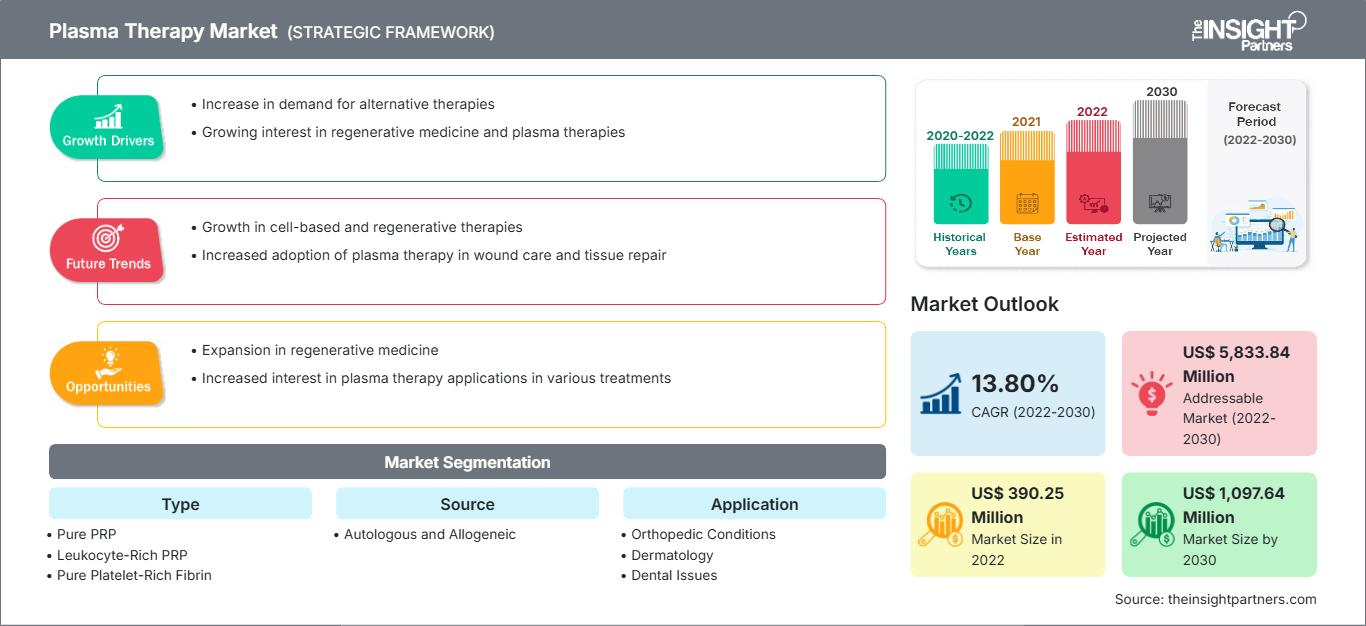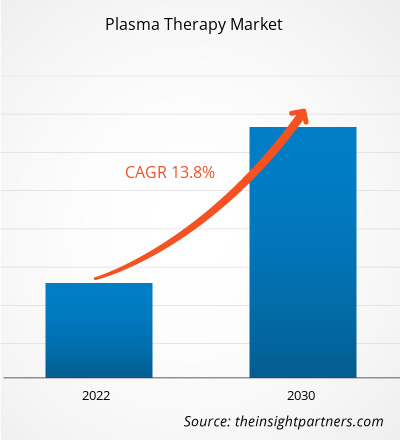[Rapporto di ricerca] Si prevede che il mercato della terapia al plasma crescerà da 390,25 milioni di dollari nel 2022 a 1.097,64 milioni di dollari entro il 2030; si stima che il mercato registrerà un CAGR del 13,80% dal 2022 al 2030.
Punto di vista dell'analista
L'analisi del mercato della terapia al plasma spiega fattori di crescita quali l'aumento dei casi di disturbi ortopedici nelle persone, soprattutto nella popolazione geriatrica; l'aumento del numero di lesioni articolari e muscolari negli atleti e la crescente domanda di procedure estetiche mini-invasive. Inoltre, la personalizzazione delle terapie al plasma in base alle esigenze dei pazienti Si prevede che le esigenze introdurranno nuove tendenze nel mercato tra il 2022 e il 2030.
La terapia al plasma, nota anche come terapia con plasma ricco di piastrine (PRP), prevede l'utilizzo del plasma sanguigno ottenuto da individui guariti con successo da una malattia per affrontare una vasta gamma di condizioni mediche e favorire il processo di guarigione. I trattamenti PRP trovano applicazione in ortopedia per il trattamento di lesioni articolari, in dermatologia per le procedure di ringiovanimento cutaneo e in odontoiatria per la riparazione dei tessuti. I fattori di crescita presenti nel PRP stimolano efficacemente la rigenerazione dei tessuti, accelerando così la guarigione delle lesioni o migliorando i meccanismi coinvolti nelle procedure estetiche.
Approfondimenti di mercato
Casi crescenti di disturbi ortopedici e Lesioni muscolari e crescente utilizzo del PRP nelle procedure estetiche alimentano il mercato della terapia al plasma
Secondo le statistiche pubblicate dall'Organizzazione Mondiale della Sanità (OMS) nel 2023, circa 528 milioni di persone in tutto il mondo convivevano con l'osteoartrite (OA) nel 2019, con un aumento del 113% dal 1990. Un articolo pubblicato su PubMed Central nel dicembre 2020 afferma che l'uso del PRP offre un potenziale per la riparazione dei tessuti grazie all'abbondanza di fattori di crescita e citochine in questo plasma, che sono cruciali nell'iniziare e modulare i microambienti rigenerativi sia per i tessuti molli che per quelli duri. La terapia con PRP può essere utilizzata nella guarigione di fratture ossee; lesioni legamentose, muscolari e tendinee; lesioni dei nervi periferici; lesioni della cartilagine articolare; e osteoartrite. Pertanto, vi è un'elevata domanda di terapie al plasma nelle procedure ortopediche e di riparazione tissutale.
Inoltre, il PRP viene utilizzato in chirurgia estetica per il ringiovanimento cutaneo, l'anti-invecchiamento e altre procedure estetiche. Dei 73 studi valutati in una revisione pubblicata su PubMed Central nel novembre 2021, 45 si sono concentrati sulla monoterapia con PRP, mentre 35 studi hanno indagato gli effetti del PRP in combinazione con il microneedling. Di conseguenza, le terapie sono state ben tollerate e adatte a tutti i fototipi. Sono stati identificati risultati positivi del trattamento per diverse condizioni, tra cui ringiovanimento cutaneo, revisione delle cicatrici, alopecia, disturbi della pigmentazione, lichen sclerosi, neuropatia periferica indotta dalla lebbra, psoriasi a placche e disturbi ungueali.
Pertanto, l'uso del PRP nella chirurgia estetica contribuisce alla crescita del mercato della terapia al plasma.
Tendenze future
Le opzioni di personalizzazione per introdurre terapie incentrate sul paziente emergono come tendenza futura nel mercato della terapia al plasma
La terapia al plasma personalizzata comporta la personalizzazione delle terapie al plasma per soddisfare le esigenze dei pazienti in base a fattori quali le loro specifiche condizioni mediche e il corredo genetico. Gli sforzi di personalizzazione sono focalizzati sul miglioramento dell'efficacia della terapia al plasma adattando la composizione di componenti come anticorpi e proteine per trattare in modo più efficace le specifiche condizioni di salute del paziente. Ricercatori e operatori sanitari stanno mettendo a frutto le loro competenze per trovare soluzioni personalizzate per la terapia al plasma in base a patologie specifiche, come malattie autoimmuni, malattie infettive e tumori rari. Aziende come Regenexx e Bridging Biosciences forniscono PRP altamente puro e concentrato, personalizzabile per eliminare le incongruenze nella guarigione dei danni tissutali e nella rigenerazione cellulare. L'USA Medical Research Institute in Texas offre la terapia PRP TruDose, che contiene dosi terapeutiche personalizzate per il trattamento di diverse patologie dolorose croniche muscoloscheletriche, LUPUS, intolleranze alimentari, malattia di Lyme e molte patologie degenerative.
Personalizza questo rapporto in base alle tue esigenze
Potrai personalizzare gratuitamente qualsiasi rapporto, comprese parti di questo rapporto, o analisi a livello di paese, pacchetto dati Excel, oltre a usufruire di grandi offerte e sconti per start-up e università
Mercato della terapia al plasma: Approfondimenti strategici

- Ottieni le principali tendenze chiave del mercato di questo rapporto.Questo campione GRATUITO includerà l'analisi dei dati, che vanno dalle tendenze di mercato alle stime e alle previsioni.
Potrai personalizzare gratuitamente qualsiasi rapporto, comprese parti di questo rapporto, o analisi a livello di paese, pacchetto dati Excel, oltre a usufruire di grandi offerte e sconti per start-up e università
Mercato della terapia al plasma: Approfondimenti strategici

- Ottieni le principali tendenze chiave del mercato di questo rapporto.Questo campione GRATUITO includerà l'analisi dei dati, che vanno dalle tendenze di mercato alle stime e alle previsioni.
Segmentazione e ambito del report
Approfondimenti basati sulla tipologia
In base alla tipologia, il mercato della terapia al plasma è segmentato in PRP puro, PRP ricco di leucociti, fibrina pura ricca di piastrine e fibrina ricca di leucociti. Il segmento della fibrina pura ricca di piastrine ha detenuto la quota di mercato maggiore nel 2022 e si prevede che registrerà il CAGR più elevato tra il 2022 e il 2030. Il PRP ricco di leucociti (LR-PRP) è un tipo di PRP che presenta una concentrazione di neutrofili (globuli bianchi) più elevata rispetto al livello basale. È generalmente associato ad effetti proinfiammatori. Tuttavia, in alcuni casi, LR-PRP può essere utile per stimolare l'infiammazione nell'organismo, indicando una condizione cronica come la tendinopatia.
Approfondimenti basati sulla fonte
Il mercato della terapia al plasma, in base alla fonte, è suddiviso in autologo e allogenico. Il segmento autologo ha dominato il mercato nel 2020.
Approfondimenti basati sull'applicazione
Il mercato della terapia al plasma, per applicazione, è segmentato in patologie ortopediche, dermatologia, problemi dentali e altri. Il segmento dermatologico ha detenuto la quota di mercato maggiore nel 2022.
Approfondimenti basati sull'utente finale
In termini di utente finale, il mercato della terapia al plasma è classificato come ospedali e cliniche, istituti di ricerca, centri chirurgici ambulatoriali (ASC) e altri. Il segmento ospedaliero ha detenuto la quota maggiore del mercato nel 2022 e si prevede che registrerà il CAGR più elevato nel mercato durante il periodo 2022-2030.
Approfondimenti regionali sul mercato della terapia al plasma
Le tendenze regionali e i fattori che influenzano il mercato della terapia al plasma durante il periodo di previsione sono stati ampiamente spiegati dagli analisti di The Insight Partners. Questa sezione illustra anche i segmenti e la geografia del mercato della terapia al plasma in Nord America, Europa, Asia-Pacifico, Medio Oriente e Africa, America meridionale e centrale.
Ambito del rapporto di mercato sulla terapia al plasma
| Attributo del rapporto | Dettagli |
|---|---|
| Dimensioni del mercato in 2022 | US$ 390.25 Million |
| Dimensioni del mercato per 2030 | US$ 1,097.64 Million |
| CAGR globale (2022 - 2030) | 13.80% |
| Dati storici | 2020-2022 |
| Periodo di previsione | 2022-2030 |
| Segmenti coperti |
By Tipo
|
| Regioni e paesi coperti | Nord America
|
| Leader di mercato e profili aziendali chiave |
|
Densità degli operatori del mercato della terapia al plasma: comprendere il suo impatto sulle dinamiche aziendali
Il mercato della terapia al plasma è in rapida crescita, trainato dalla crescente domanda degli utenti finali, dovuta a fattori quali l'evoluzione delle preferenze dei consumatori, i progressi tecnologici e una maggiore consapevolezza dei benefici del prodotto. Con l'aumento della domanda, le aziende stanno ampliando la propria offerta, innovando per soddisfare le esigenze dei consumatori e sfruttando le tendenze emergenti, alimentando ulteriormente la crescita del mercato.

- Ottieni il Mercato della terapia al plasma Panoramica dei principali attori chiave
Analisi regionale
Il Nord America ha dominato il mercato della terapia al plasma nel 2022. Si prevede inoltre che registrerà il CAGR più elevato del mercato tra il 2022 e il 2030. Il mercato in Nord America è segmentato in Stati Uniti, Canada e Messico. Gli Stati Uniti detengono la quota di mercato maggiore del mercato globale della terapia al plasma. La crescita del mercato nel Paese è attribuita alla crescente adozione del plasma ricco di piastrine (PRP) nella chirurgia ortopedica ed estetica, ai crescenti investimenti nel settore sanitario, al dinamico panorama della ricerca e sviluppo e all'approvazione della FDA statunitense per alcune terapie PRP.
Il rapporto descrive i principali attori che operano nel mercato globale della terapia al plasma. Tra questi figurano BioLife Plasma Services; Takeda Pharmaceutical Company Limited; Biotest AG CSL Ltd.; Grifols, SA; Kedrion SpA; ImmunoTek Bio Centers; Bio Products Laboratory Ltd.; China Biologic Products Holdings, Inc.; Octapharma AG e Origin, Inc. Questi attori leader si concentrano sull'espansione e la diversificazione della loro presenza sul mercato e della loro clientela, sfruttando così le opportunità commerciali prevalenti.
Sviluppi chiave dei principali attori del mercato sono:
- A marzo 2023, BioLife Plasma Services ha annunciato l'apertura del suo centro di donazione del plasma negli Stati Uniti, con nuove sedi a West Springfield (Massachusetts) e Pearland (Texas). Questa espansione aiuterà l'azienda ad ampliare la sua rete commerciale.
- A febbraio 2021, Atlas Health Medical Group ha lanciato SkinPen. Questo piccolo dispositivo a microaghi a forma di penna contenente PRP per lifting del viso perfora la pelle e stimola una risposta anti-invecchiamento.
- Nel marzo 2020, Takeda Pharmaceutical Company Limited ha avviato lo sviluppo di una globulina iperimmune policlonale (H-Ig) anti-SARS-CoV-2 per curare i soggetti affetti da COVID-19 grave.
- Analisi storica (2 anni), anno base, previsione (7 anni) con CAGR
- Analisi PEST e SWOT
- Valore/volume delle dimensioni del mercato - Globale, Regionale, Nazionale
- Industria e panorama competitivo
- Set di dati Excel
Report recenti
Testimonianze
Motivo dell'acquisto
- Processo decisionale informato
- Comprensione delle dinamiche di mercato
- Analisi competitiva
- Analisi dei clienti
- Previsioni di mercato
- Mitigazione del rischio
- Pianificazione strategica
- Giustificazione degli investimenti
- Identificazione dei mercati emergenti
- Miglioramento delle strategie di marketing
- Aumento dell'efficienza operativa
- Allineamento alle tendenze normative




















 Ottieni un campione gratuito per - Mercato della terapia al plasma
Ottieni un campione gratuito per - Mercato della terapia al plasma